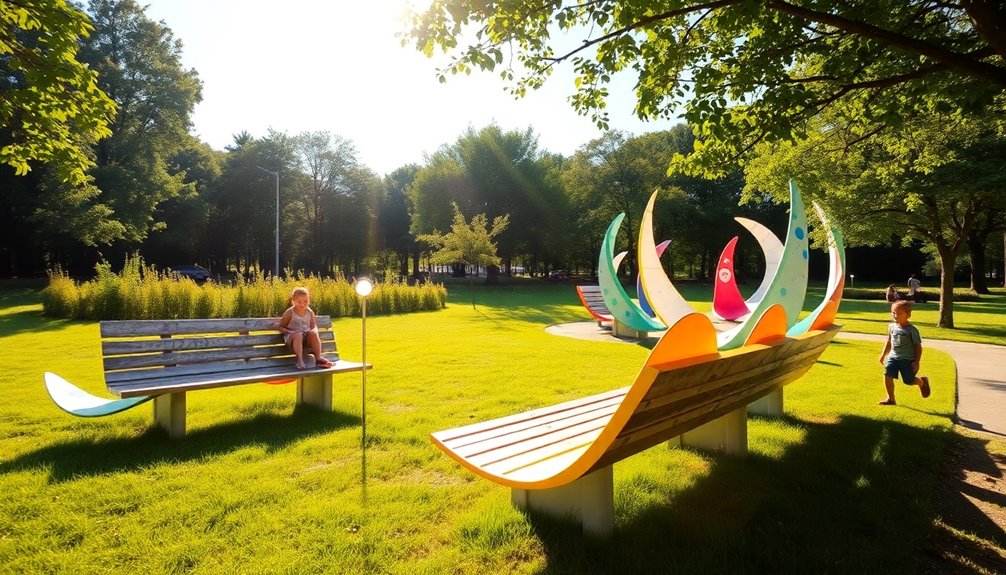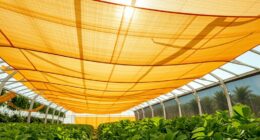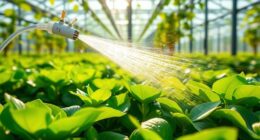Repurposing old wind turbine blades can help you tackle the 800,000 tons of waste generated each year. Innovative strategies turn these blades into surfboards, road materials, and even playground equipment. As you explore techniques like fiberglass recycling and new biomaterials, you'll see how this movement fosters a circular economy. Not only does it reduce landfill waste, but it also boosts local economies and supports global sustainability goals. Discover how these solutions can transform waste into valuable resources.
Key Takeaways
- Innovative repurposing strategies, such as surfboards and park benches, transform old wind turbine blades into valuable products, promoting sustainable resource management.
- Advanced recycling technologies, like Carbon Rivers' fiberglass recycling, facilitate the circular economy by recovering and reusing materials from turbine blades.
- Repurposing blades can significantly reduce CO2 emissions, supporting global net-zero goals and enhancing environmental sustainability.
- Economic benefits include job creation in recycling industries and reduced costs for raw materials, stimulating local economies.
- Collaborations between companies emphasize responsible disposal and innovative reuse, driving investment in sustainable practices and technologies.

As the wind energy sector grows, the challenge of disposing of old wind turbine blades becomes increasingly pressing. You mightn't realize that around 800,000 tons of these blades are discarded annually, primarily made from glass or carbon fiber composites. These materials are notoriously difficult to recycle, often leading to blades ending up in landfills or being incinerated, where they don't degrade quickly. This situation raises significant environmental concerns due to the long-term impact on our planet.
However, innovative repurposing strategies are emerging to tackle this waste problem. Companies like Draft Surf are turning old blades into surfboards, while others are finding new life for them as materials in road asphalt and decking. Imagine sitting on a park bench made from decommissioned blades or seeing them used in playground equipment. Additionally, Acciona's role in collaborating with Draft Surf highlights the importance of responsible blade disposal to manage this growing waste stream. Furthermore, these initiatives align with geothermal heat pumps that utilize renewable energy sources to mitigate environmental impact.
Even more intriguing is the idea of transforming these materials into raw filaments for 3D printing or using them as structural components for highway overhead signs.
Technological advancements play a crucial role in these initiatives. The National Renewable Energy Laboratory is developing new biomaterials like PECAN, which can make blades recyclable. Moreover, innovations like Carbon Rivers' fiberglass recycling technology are capturing and reusing glass fibers from old blades, fostering a circular economy.
By focusing on upcycling, you help create reusable materials from decommissioned blades, generating job opportunities in the process.
The environmental benefits are significant, too. Repurposing blades can help reduce CO2 emissions, supporting global net-zero goals while conserving resources. With this approach, you contribute to sustainable infrastructure development and decrease the amount of waste going to landfills.
Repurposing wind turbine blades significantly cuts CO2 emissions and promotes sustainable infrastructure while minimizing landfill waste.
Plus, the economic impacts are promising: reduced raw material costs and job creation in recycling and upcycling industries.
Frequently Asked Questions
How Long Do Wind Turbine Blades Typically Last Before Needing Replacement?
Wind turbine blades typically last around 20 years, but they can extend up to 25 years depending on conditions.
You'll find that factors like material quality, environmental influences, and regular maintenance play a big role in their longevity.
If you're involved in managing wind energy, it's crucial to keep up with inspections and proactive care to ensure optimal performance and delay any premature replacements, maximizing both efficiency and lifespan.
What Materials Are Wind Turbine Blades Made From?
Imagine a warrior's shield, crafted from strong yet lightweight materials to withstand fierce battles.
Wind turbine blades share this spirit, primarily made from composite materials like fiberglass and carbon fiber.
These blades, much like that shield, rely on epoxy and polyester resins for resilience.
Their core, often foam or balsa wood, provides structural integrity, ensuring they bravely face the elements while harnessing nature's energy for a sustainable future.
Are There Any Health Risks Associated With Blade Repurposing?
Yes, there are health risks associated with blade repurposing.
If you're handling the materials, you might face inhalation risks from particulates during processing. Improper handling could expose you to harmful chemicals released during decomposition.
It's crucial to use protective equipment and follow safety guidelines to minimize these risks.
Additionally, the durability of the materials means they can persist in the environment, which can pose long-term health concerns if not managed properly.
How Are Old Blades Currently Disposed of if Not Repurposed?
If old wind turbine blades aren't repurposed, you'll find they're usually landfilled or incinerated.
Landfilling is the most common approach in the U.S., though it raises environmental concerns due to methane release. Incineration, while recovering some energy, incurs high costs and produces harmful ash.
Despite their non-toxic materials, the long-term impacts of these disposal methods on air quality and the environment are significant, prompting calls for more sustainable solutions.
What Industries Are Most Interested in Repurposing Wind Turbine Blades?
Construction, art, and environmental industries are most interested in repurposing wind turbine blades.
You'll find construction firms using them for beams and roofing, while artists transform them into unique furniture and outdoor installations.
Environmental groups focus on reducing landfill waste and enhancing sustainability.
Each industry sees the potential to innovate, reduce costs, and promote eco-friendly practices.
Conclusion
In conclusion, repurposing old wind turbine blades isn't just a smart move; it's a game-changer for sustainable resource management. By transforming these massive structures into innovative products, you're not only reducing waste but also opening up a world of creative possibilities. Imagine turning those towering blades into something extraordinary—like a playground for your community! So, let's embrace this circular strategy and make our planet a better place, one wind turbine blade at a time.









